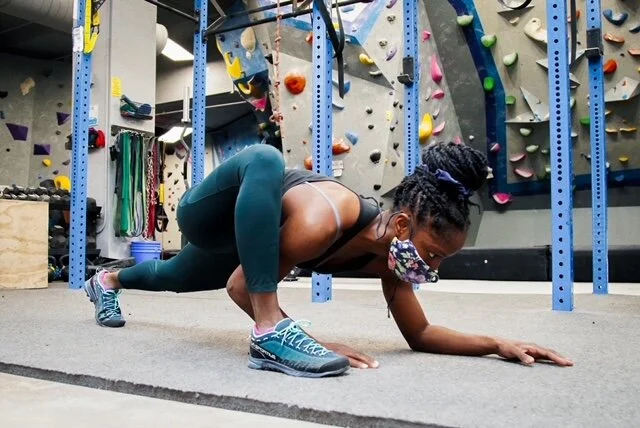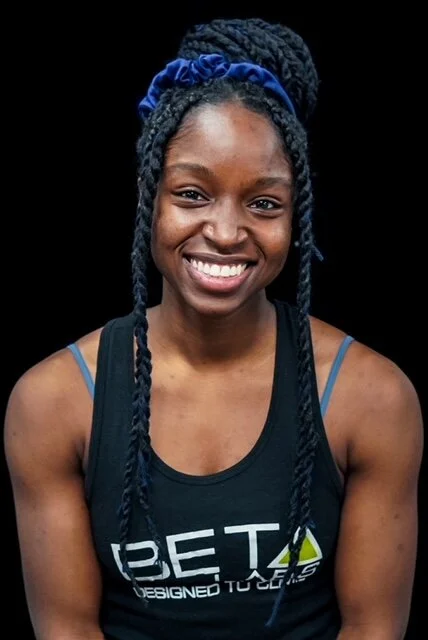Women at Work: Adeline Wright
To be a climber, you have to be resilient. You need to be able to assess difficulties and risks, solve problems creatively, and push yourself past the limits of what you think your body can endure. Like most sports, climbing demands a certain level of fitness, but it also takes courage in the face of fear, or rather, nerve, to stare at a wall or mountain and say, “Yeah, I’m going to climb to the top of that thing.”
Enter Adeline Wright, an athlete, a physical therapist in training, and a climbing Instructor at Central Rock Gym from the Bronx, NY. When I was introduced to Ady’s Instagram page by a mutual friend, I instantly knew that I had to interview her for my Women at Work series. Just from browsing through her posts for a few minutes, I found myself itching to give climbing a go, something I’ve never really considered, given my unease with heights and general lack of upper body strength.
Ady’s refreshing honesty, positive energy, and passion for the sport are not only evident but very infectious. “I love to climb because it allows me to push myself mentally and physically, teaches me to be patient, offers me a community to enjoy the outdoors, and makes me incredibly happy,” she enthusiastically explains. “I can’t imagine life without it.”
Check out this video on YouTube featuring Ady to learn all about the differences between tall vs. short climber beta! Photo Credit: Goldie Choi
Ady has received sponsorships from Beta Labs, Tension Climbing, La Sportiva, Arc’teryx, and Gunks App, boasting an already impressive list of accomplishments under her belt, including placing in the finals at the Cliffs Long Island City boulder competition in March 2020, first in several Flash Friday boulder competitions at steep Rock Boulders, and first in the Royal Riot boulder competition at Brooklyn Boulders in May 2019. Ady has also created and taught various climbing technique clinics and free introduction to climbing clinics for Arc’teryx and Backcountry.
Moreover, Ady has hosted free virtual slab climbing technique clinics for Brown Girls Climb, a company owned and operated by Women of Color that increases visibility and diversity in climbing and creates inclusive opportunities to climb and explore for underrepresented communities. “I’m hoping that as a trailblazer, I can inspire the Black community to venture outdoors and try rock climbing.”
Want to book a private climbing lesson with Ady at Central Rock Gym in Manhattan? Contact: Magenta1993@gmail.com
How did you discover rock climbing?
My Mom works at a hospital that has a small top rope wall for staff and family to try. It’s run by the students attached to the associated college, and we tried it when I was in the 10th grade. I didn’t try it again until college as a way to work out, and I took multiple long-term breaks from it. It wasn’t until I got a membership at a rock climbing gym in 2013 that I learned about bouldering, grades, competitions, and sponsored athletes for the sport. My true climbing started then.
Can you describe what you’re thinking while ascending a climb?
When I’m climbing, I think about my body positioning, the way my muscles and joints feel to determine what kind of session to have, and I'm generally just relishing in the climbing experience itself.
How do you go about designing a rock climbing course? Essentially, what should you include and avoid when setting a wall route?
When setting, I start by looking at the wall angles I’ll be using and try to think of any movements I’d like to create. If I don’t feel inspired, I’ll look at the hold choices and set with holds that interest me. Halfway through picking hold types, I’ll come across some sort of movement I’d like to teach. From that point, I pick the grade range I’m aiming for and get started. For organization’s sake, I pick the correct bolt size per hold and add chalk to each before I put them on the wall.
Some things that should be included are the distance between foot and hand holds to make sure most of the clientele can reach. It’s impossible to make sure every size is comfortable on the climb as the routes get harder, but we do our best. Some climbs will favor the short climbers, and the kids won’t be able to access some others. Some things that should be avoided are dangerous falls, the ability for holds to spin if weight is put on one side, unnecessary awkward hold positions, and the separation of certain colors so that color-blind climbers can enjoy the route.
Where are your favorite places to go rock climbing?
My favorite places to climb are Peter’s Kill in upstate NY, Central Rock Manhattan, GP 81 in Brooklyn, and Method Climbing Gym in Newark.
What do you do to ready yourself for a challenging climb or a competition? Do you find that it’s something you have to emotionally or mentally prepare yourself for?
I first prepare my body with sufficient rest and nutrition. I need about 7 hours of sleep to be in tip-top shape. I make sure to have a balanced meal the night before and a light breakfast the morning of. I drink tons of water as well.
Mentally, I psych myself up by thinking of all my past successes and the fact that climbing is supposed to be fun. If I get too serious and can’t crack a smile, then I need to walk away for a bit. If I’m working on a project, then I “mime” the climb in my head and look at my recorded beta. If I’m going to a competition, I remember some tips that I often forget, like breathing, taking at least a 1 minute rest between attempts, and some climbing techniques such as moving with intent.
Have you encountered any pushback or barriers in terms of your race, gender, or socio-economic class while pursuing rock climbing as a sport? Would you say that access is given to one group over another?
I’ve definitely encountered socio-economic barriers in climbing. Climbing, like many sports, is expensive to get into because you have to make quite an investment at the start. Climbing shoes, harness, and instruction are just the start. If you climb indoors, you need a gym membership; if climbing outdoors, you need a crash pad. Another barrier is just knowing someone who is a responsible outdoor climber that can teach you about your responsibilities to the crag, other climbers, the locals and help you transition from indoors to outdoors. If you don’t have access to a mentor, then you have to pay a guide to teach you. Local competitions are also tough to access because the gyms outside of New York City are usually pretty far from public transit. So I would carpool with someone (rarely had the opportunity) or take a cab from the nearest public transit.
As a Black woman, it's hard to tell in the early years if any barriers I faced were because of gender or race. I was always a rarity in the climbing space as both a woman and a Black climber, so I didn’t see the representation others had and wasn’t afforded opportunities until I was regarded as “strong.” I really had to advertise myself and network. Not having access to an affinity space meant that I was trailblazing, which is lonely and a bit painful. The climbing community is improving, but I would say access is definitely given to white males with financial security more often than not, so that would be the older white males who gatekeep access to the sport.
To piggyback off the last question, what do you think needs to change regarding climbing culture to make it more inclusive and intersectional?
Some things that could be done are first removing the financial barriers that deny people access to the sport. Representation is just as important, so all aspects of the climbing community should include people of varying identities. Sponsored athletes, leadership positions in gyms, setting crews, board members of outdoor organizations, owner/management positions in product companies, accredited guide positions, directors/films in climbing film festivals, and writers/editors in prominent outdoor magazines need a LOT more diversity.
The last change I can think of is providing affinity spaces run by those who identify with the group. This will not only allow them to ask for and receive what they need to feel included and respected, but it will attract others to climbing because they will be able to try the sport in a safe space.
Where is your dream destination to go rock climbing?
I would looooove to go to Hueco Tanks in Texas and The Rocklands in South Africa!
What does climbing mean to you? Specifically, what motivates you to pursue this sport?
The climbing community is where I can interact with other people that enjoy the outdoors and this sport that I love. It’s also a space that allows me to have superpowers. I get to be as tall as I want to be and flow smoothly up a challenging route at my own pace. My progression is always measured by my past and where I am at the moment. I don’t need a particular body type to succeed because I can build up the strength I need to complete a task. It's incredibly rewarding to be able to climb because it's given me all of my physical self-confidence and taken me out of my shell.
Do you have any advice for people who want to start climbing but are too intimidated to try?
My advice for anyone interested in trying the sport is to just try it. Any and almost everyone can do it. Clip your nails, pack some thin socks, gym clothes, and water, then walk right into your local climbing gym. If inclusivity is an issue, then do a quick google search for a non-profit group that aims to include their particular identity/identities so that they can feel comfortable in the space. Not every group is social media savvy, but if you look long enough, you’ll find the right group for you.
BADASS ALERT
Watching Ady dominate indoor and outdoor courses is genuinely empowering. Her motivational words and gravity-defying videos are sure to encourage many climbers and potential climbers, no matter their skill level, to try their best, push their boundaries, and be a more active participant in their lives. For more information about Adeline Wright and her rock climbing adventures, follow @adyclimbs on Instagram or Small But Mighty Blog!







